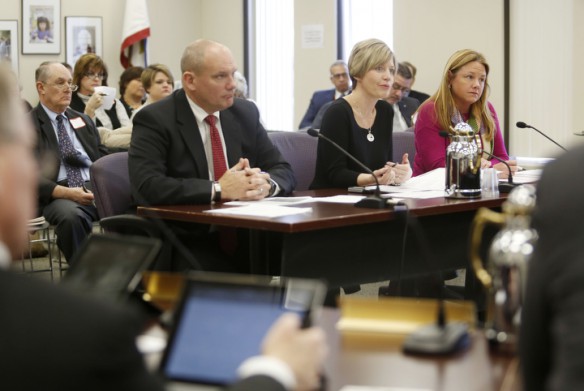
Kentucky Department of Education Chief of Staff Tommy Floyd and Associate Commissioners Amanda Ellis and Kelly Foster discuss closing the achievement gaps through novice reduction with the Kentucky Board of Education during its meeting.
Photo by Amy Wallot, Feb. 4, 2015
By Brenna R. Kelly
brenna.kelly@education.ky.gov
It’s one of the most vexing issues educators face – closing the achievement gap – which is why Kentucky Department of Education officials recently announced a new plan for how they will assist districts and schools in raising achievement for all students.
“We know in this state if we partner with districts to have a laser-like focus on issues, results happen,” said Kelly Foster, associate commissioner of KDE’s Office of Next Generation Schools and Districts, which works to raise student achievement by supporting districts. “We’ve seen that with college and career-readiness.”
In a nutshell, the state’s plan is focused on decreasing the number of students performing at the Novice level under the state’s accountability model, and raising the achievement among specific groups of students, such as minorities and students in poverty, who tend to lag behind their white, more economically advantaged classmates.
“If we can create the same intensity around closing achievement gaps through novice reduction, kids will be impacted in great ways,” Foster said while presenting the plan at a recent Kentucky Board of Education (KBE) meeting.
KBE has made closing achievement gaps one of its top priorities. Under state law, KBE and districts are required to address the gaps in achievement between African-American and white students, male and female students, students with and without disabilities, students with limited English proficiency and English speakers, and students who qualify for free or reduced-price lunch and students who do not.
But that’s not the only reason the department has chosen to focus on novice reduction to close gaps, said KDE Chief of Staff Tommy Floyd.
“It’s is not about compliance, rather it’s about an ethical imperative,” he said. “We believe it’s about reaching each child, regardless of where they are on the continuum of learning.”
In the last Unbridled Learning College- and Career-Readiness for All Accountability results, 20 percent of the state’s elementary students ranked at the Novice level in reading, the lowest of four possible rankings. In mathematics, 17 percent of elementary students performed at the Novice level.
The Novice percentage was even higher at the high school level, with 33 percent of students at the Novice Level in reading and 24 percent in math.
By focusing on moving all students out of Novice performance, achievement gaps should begin to improve, officials believe.
The state has already made some gains in the achievement of students who fall into one of the gap groups. Since Unbridled Learning was implemented three years ago, the percentage of students in the non-duplicated gap group that scored Proficient or Distinguished in reading and math has increased from 33 percent to 38 percent.
But there are still gaps between certain groups of student in Kentucky schools.
For example, in the 2013-14 school year, 75 percent of white females who were not in poverty scored Proficient or higher in elementary reading, while 50 percent of white females who were in poverty were Proficient or higher. In elementary math, 65.8 percent of white males who were not in poverty scored Proficient or higher, while 51.7 percent of African-American males who were not in poverty scored Proficient or higher.
The department’s plan to reduce Novice performance will cut across curriculum, instruction, interventions, accountability and assessment, officials said. It will refine the department’s approach to supporting schools and districts.
There are eight core work areas in which the department will work with districts:
- design and deploy standards
- design and deliver instruction
- design and deliver assessment literacy process
- review, analyze and apply data results
- design, align and deliver support processes
- establish learning culture and environment
- align community support partners
- monitor implementation of legal requirements
The most effective strategies within those areas will be will be identified and shared with schools and districts so they will have resources to use as they review their work focus on Novice reduction.
The department is still determining what processes and measures will have the most effect on student achievement and which tools are already in place, but perhaps underutilized by schools and districts, said Associate Commissioner Amanda Ellis, who heads KDE’s Office of Next Generation Learners, which provides supports to teachers and students.
The idea isn’t to add more work, but to figure out what’s working and what’s not, she said.
“We have lots of tools in our tool box that we are not using, or are we not promoting collectively and consistently to the field,” Ellis said.
The goal is to have the novice reduction plan ready for the Superintendents’ Summit in September.
“It’s not just about moving a test score,” Ellis said. “It’s going to have to change what’s going on in core instruction every single day in the classroom.”
Floyd said he would have liked to have had this kind of help coordinating and maximizing all the supports for his lowest-performing students when he was a superintendent.
“When you look at the people that are doing the difficult jobs as superintendents, principals and teachers out there, our role as an agency is to give them options to choose from that best fit their needs,” Floyd said. “We have to give them something that is true and tested and dependable, that will make a difference or we’ve not supported them at the level that they really need to make an articulated set of consistent decisions about how to close those gaps.”
MORE INFO….
Kelly Foster kelly.foster@education.ky.gov
Amanda Ellis amanda.ellis@education.ky.gov
Tommy Floyd tommy.floyd@education.ky.gov



Leave A Comment